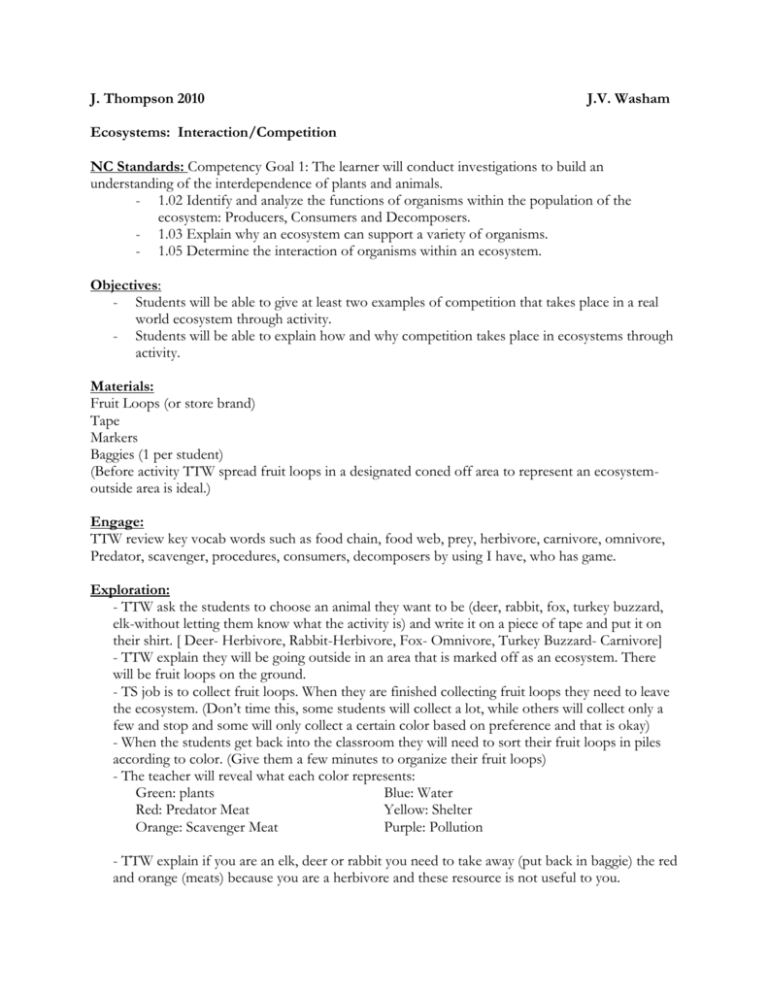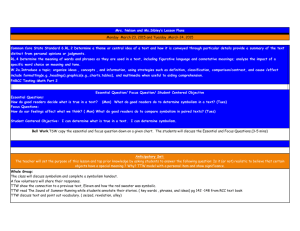competition lesson plan
advertisement

J. Thompson 2010 J.V. Washam Ecosystems: Interaction/Competition NC Standards: Competency Goal 1: The learner will conduct investigations to build an understanding of the interdependence of plants and animals. - 1.02 Identify and analyze the functions of organisms within the population of the ecosystem: Producers, Consumers and Decomposers. - 1.03 Explain why an ecosystem can support a variety of organisms. - 1.05 Determine the interaction of organisms within an ecosystem. Objectives: - Students will be able to give at least two examples of competition that takes place in a real world ecosystem through activity. - Students will be able to explain how and why competition takes place in ecosystems through activity. Materials: Fruit Loops (or store brand) Tape Markers Baggies (1 per student) (Before activity TTW spread fruit loops in a designated coned off area to represent an ecosystemoutside area is ideal.) Engage: TTW review key vocab words such as food chain, food web, prey, herbivore, carnivore, omnivore, Predator, scavenger, procedures, consumers, decomposers by using I have, who has game. Exploration: - TTW ask the students to choose an animal they want to be (deer, rabbit, fox, turkey buzzard, elk-without letting them know what the activity is) and write it on a piece of tape and put it on their shirt. [ Deer- Herbivore, Rabbit-Herbivore, Fox- Omnivore, Turkey Buzzard- Carnivore] - TTW explain they will be going outside in an area that is marked off as an ecosystem. There will be fruit loops on the ground. - TS job is to collect fruit loops. When they are finished collecting fruit loops they need to leave the ecosystem. (Don’t time this, some students will collect a lot, while others will collect only a few and stop and some will only collect a certain color based on preference and that is okay) - When the students get back into the classroom they will need to sort their fruit loops in piles according to color. (Give them a few minutes to organize their fruit loops) - The teacher will reveal what each color represents: Green: plants Blue: Water Red: Predator Meat Yellow: Shelter Orange: Scavenger Meat Purple: Pollution - TTW explain if you are an elk, deer or rabbit you need to take away (put back in baggie) the red and orange (meats) because you are a herbivore and these resource is not useful to you. - TTW explain if you are a buzzard you need to take away green (plants). TTW also explain that if you are a buzzard you need to take away red as they are scavengers. - At this point, “the game” begins of who stays alive. - TTW say “For every purple (pollution) you have- it takes away one water or food source as it contaminates it. (Some may “die” at this point and they should go to the corner of the room.) - TTW then say, “You need to have 5 waters, 5 food source, 5 shelters to survive the first round.” Those who “die” from not having enough resources go to one corner of the room. Everyone else puts the fruit loops they used in the baggie because those are used resources. - TTW say to the ones alive, “You now need 4 water, 4 food source, 4 shelters.” A few more will “die”. - TTW then say, “The buzzards can take 5 food sources from someone next to them that is ‘dead’.” (This is because they would have more food sources if things die off because they are scavengers) - TTW then say, “You know need 4 water, 4 food source, 4 shelters.” A few more will “die”. This will go on until you have a few left. The process will show how competition between animals affects an ecosystem. Explanation: - Competition between organisms exists in every ecosystem. Organisms are forced to compete against their own species and also different species in order to survive. The stronger and fit organisms have an advantage over those who are weaker, and they have a better chance of surviving. - Competition between the same species is called intraspecific competition. Many birds of the same species compete for the best nesting grounds. In cases when food or water is scarce, members of the same species will compete for food in order to survive. - Competition between different species is called interspecific competition. Different species often compete for space, food, or water. For example the lion and the hyena both compete for zebra. Elaboration/Reflection: Think-pair-share In their science notebooks, the students will “think” about what this activity represents and why. TTW explain that the students will work with their groups (pair) to determine how it works and be able to explain competition using the terms. Each group should select a spokesperson to explain their group’s explanation as to why this represents competition. (Share) Evaluation: Exit Slip- How does competition affect an ecosystem? Explain. Answer: Competition is when two or more organisms seek the same resource at the same time and they fight for the food/living space/and other resources they need to survive. It affects the ecosystem because of how the resources and organisms interact.











